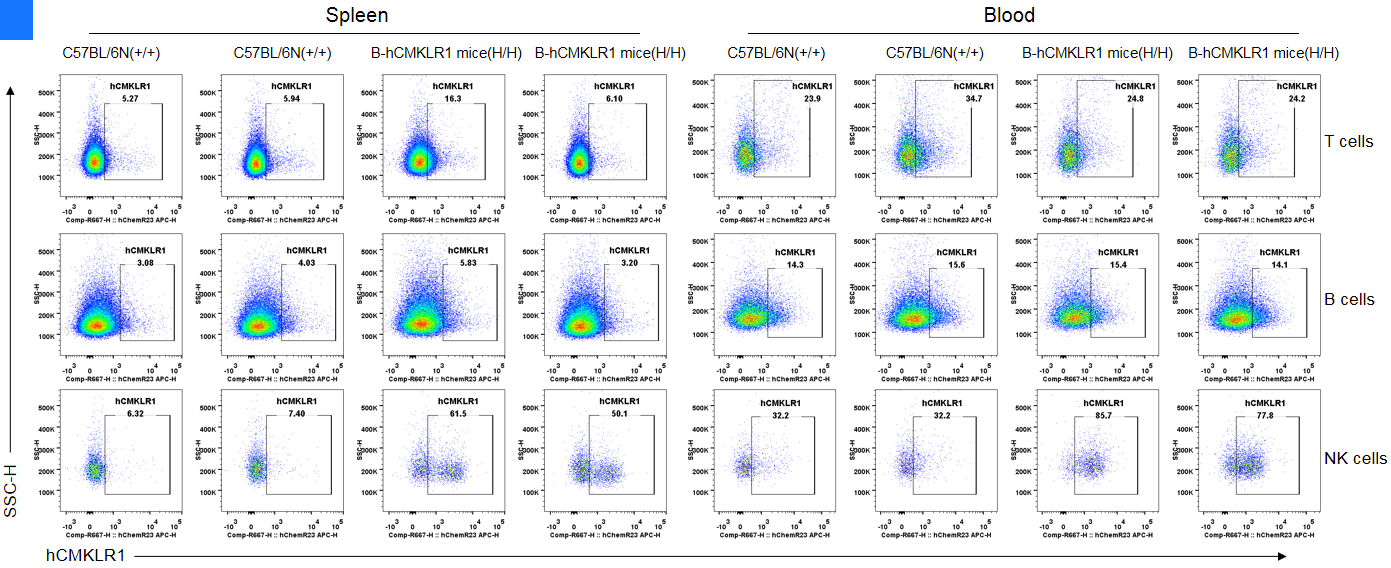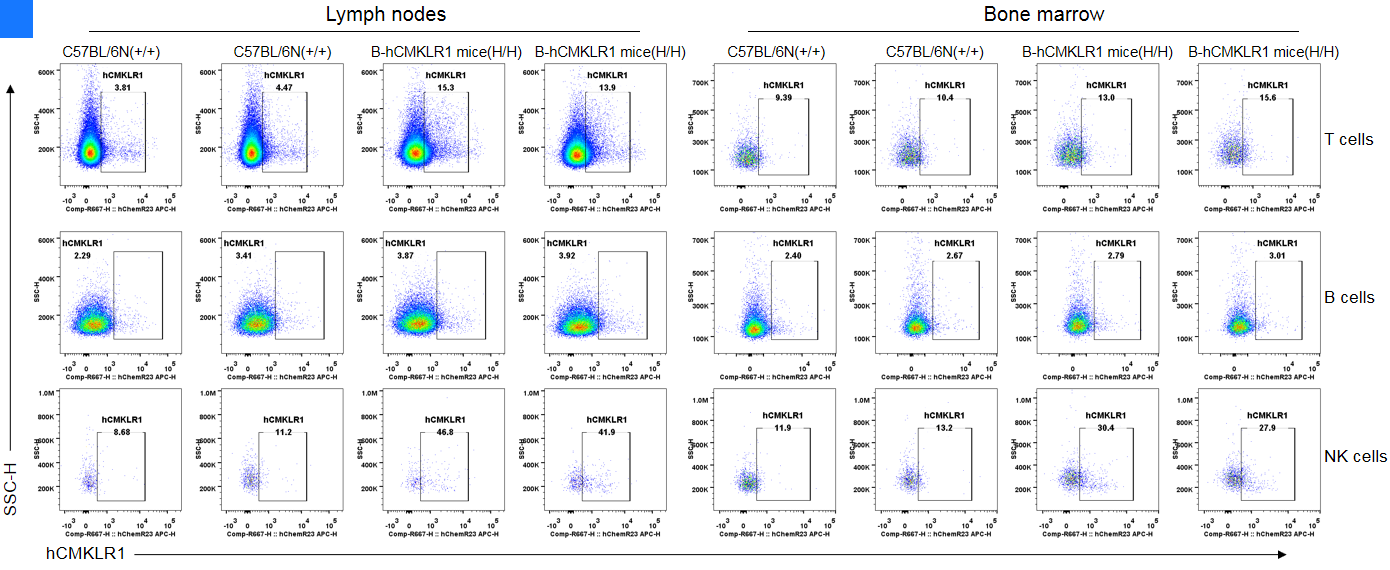|
Strain Name
|
C57BL/6N-Cmklr1tm1(CMKLR1)Bcgen/Bcgen
|
Common Name
|
B-hCMKLR1 mice
|
|
Background
|
C57BL/6N
|
Catalog number
|
112875
|
Aliases
|
CHEMERINR, ChemR23, DEZ, ERV1, RVER1
|
Description
-
CMKLR1 also known as ChemR23, is the receptor for the chemoattractant—chemerin.
-
The exon 3 of mouse Cmklr1 gene that encodes the full-length protein was replaced by human CMKLR1 exons 3-4 in B-hCMKLR1 mice.
-
CMKLR1 protein was detected in spleen, blood, lymph node and bone marrow of homozygous B-hCMKLR1 mice
-
Application: This product is used for pharmacodynamics and safety evaluation of anti-inflammatory drugs.
Targeting strategy
Gene targeting strategy for B-hCMKLR1 mice. The exon 3 of mouse Cmklr1 gene that encodes the full-length protein was replaced by human CMKLR1 exons 3-4 in B-hCMKLR1 mice.
mRNA expression analysis

Strain specific analysis of CMKLR1 mRNA expression in wild-type C57BL/6 mice and B-hCMKLR1 mice by RT-PCR. Spleen RNA was isolated from wildtype C57BL/6 mice (+/+) and homozygous B-hCMKLR1 mice (H/H), then cDNA libraries were synthesized by reverse transcription, followed by PCR with mouse or human CMKLR1 primers. Mouse Cmklr1 mRNA was detectable in wild-type C57BL/6 mice. Human CMKLR1 mRNA was detectable only in homozygous B-hCMKLR1 mice but not in wild-type mice. Specially, the human CMKLR1 isoform b was actually transcribed in B-hCMKLR1 mice.
Protein expression analysis

Strain specific CMKLR1 expression analysis in homozygous B-hCMKLR1 mice by flow cytometry. Splenocytes and blood cells were collected from wild-type C57BL/6N mice (+/+) and homozygous B-hCMKLR1 mice (H/H), and protein expression was analyzed with anti-human CMKLR1 antibody (R&D, 84939) by flow cytometry. hCMKLR1 was detectable in T cells, B cells and NK cells of homozygous B-hCMKLR1 mice and wild-type C57BL/6N mice.

Strain specific CMKLR1 expression analysis in homozygous B-hCMKLR1 mice by flow cytometry. Splenocytes and blood cells were collected from wild-type C57BL/6N mice (+/+) and homozygous B-hCMKLR1 mice (H/H), and protein expression was analyzed with anti-human CMKLR1 antibody (R&D, 84939) by flow cytometry. hCMKLR1 was detectable in monocytes and macrophages of homozygous B-hCMKLR1 mice and wild-type C57BL/6N mice.

Strain specific CMKLR1 expression analysis in homozygous B-hCMKLR1 mice by flow cytometry. Splenocytes and blood cells were collected from wild-type C57BL/6N mice (+/+) and homozygous B-hCMKLR1 mice (H/H), and protein expression was analyzed with anti-human CMKLR1 antibody (R&D, 84939) by flow cytometry. hCMKLR1 was detectable in neutrophils and DCs of homozygous B-hCMKLR1 mice and wild-type C57BL/6N mice.

Strain specific CMKLR1 expression analysis in homozygous B-hCMKLR1 mice by flow cytometry. Lymph nodes and bone marrow were collected from wild-type C57BL/6N mice (+/+) and homozygous B-hCMKLR1 mice (H/H), and protein expression was analyzed with anti-human CMKLR1 antibody (R&D, 84939) by flow cytometry. hCMKLR1 was detectable in T cells, B cells and NK cells of homozygous B-hCMKLR1 mice and wild-type C57BL/6N mice.

Strain specific CMKLR1 expression analysis in homozygous B-hCMKLR1 mice by flow cytometry. Bone marrow was collected from wild-type C57BL/6N mice (+/+) and homozygous B-hCMKLR1 mice (H/H), and protein expression was analyzed with anti-human CMKLR1 antibody (R&D, 84939) by flow cytometry. hCMKLR1 was detectable in monocytes, macrophages, neutrophils and DCs of homozygous B-hCMKLR1 mice and wild-type C57BL/6N mice.















